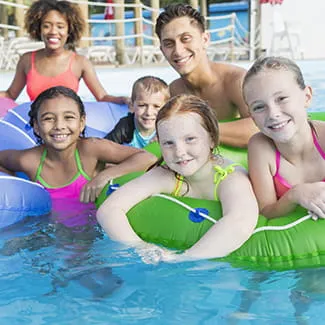May 02, 2022

May is National Water Safety Month and the Denver Health Trauma and Injury Prevention Program would like to promote fun and safety in, on, and around the water for all ages and abilities!
Preventing loss of life is something we talk a lot about within the trauma community — three children die every day as a result of drowning according to the Centers for Disease Control and Prevention (CDC).
National Water Safety Month is an awareness campaign that focuses on safe practices in, on, and around the water and reducing injury while enjoying aquatic activities. Swimming and other water-related activities are increasingly popular this time of year, so it’s helpful to be reminded of safe water practices.
Water Safety Checklist
Get ready for a fun and enjoyable swim season by using our water safety checklist. Check off the items as you review them and take action now so that you’re ready for poolside fun. Share the checklist with others so we can all bring attention to water safety. We can work together to make a real difference in water safety in our communities.
- Learn to Swim Swimming is fun! Surprisingly, more than 50 percent of Americans can’t swim or don’t have the basic swimming skills. Learning to swim is one of the most important ways to prevent water safety incidents. Equip your children (and yourself) with the skills they need to be safe and confident in and around the water. Studies show that participation by kids aged 1-4 years in formal swimming lessons can reduce the risk of drowning by 88 percent. Check with your local YMCA facility or swim school for a list of upcoming classes and sign up! Who knows? You may find a new favorite sport.
- Make it Social The water is more fun with friends! Always swim with a buddy. Don’t allow anyone to swim alone, even at pools with lifeguards. It’s a good idea to keep a cell phone nearby in case there is a need to call for help. When you’re boating, be sure to go with a friend or two and wear a life jacket.
- Monitor Children in and around water Never leave a child unattended around the water. Appoint a responsible adult as the “Water Watcher” so children are always monitored. Stay within arm’s reach of little ones and stay focused on them. Remove toys from the water when the kids are not playing with them – toys can be a powerful attraction to inexperienced or untrained swimmers. Train children in safe practices such as walking – not running – at the pool. Always wear a life jacket in open water.
- Educate Yourself Learn CPR and rescue breathing. Keep a life-saving ring, shepherd’s hook and CPR instructions mounted at poolside. If a child is missing, always check the pool first. Seconds count. Empty water in buckets or wading pools when you are done.
- Create a Safe Pool Environment A safe pool is a fun pool. There are many things you can do to improve the safety of your backyard pool. Pools should be fenced in (at least 60 inches tall, with a self-closing, self-latching gate). Gates should open away from the pool and should never be propped open. Maintaining your pool on a regular basis will also go a long way to keeping the environment safe.
For additional information on water safety, please contact Missy Anderson at 303-602-7623 or Melissa.Anderson@dhha.org.

